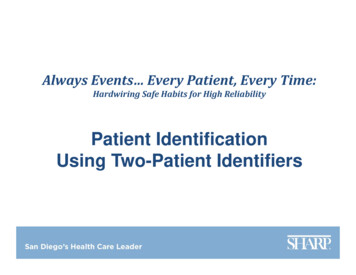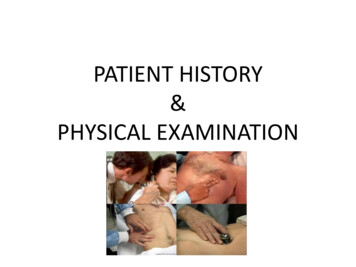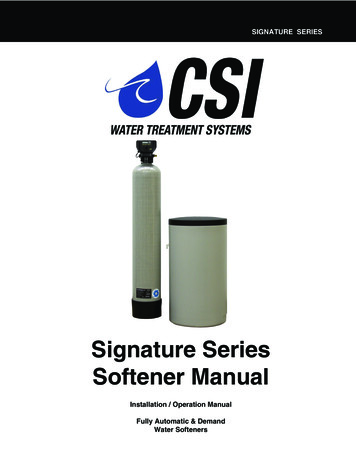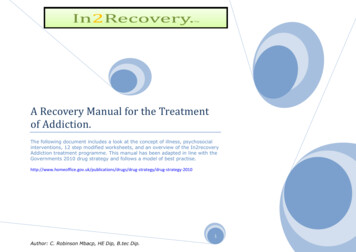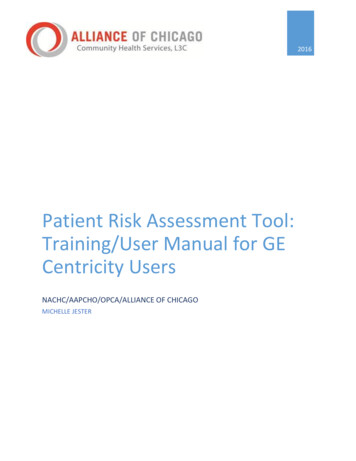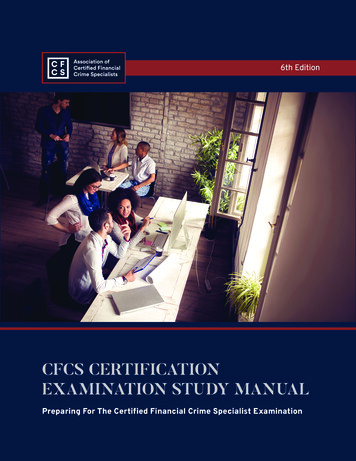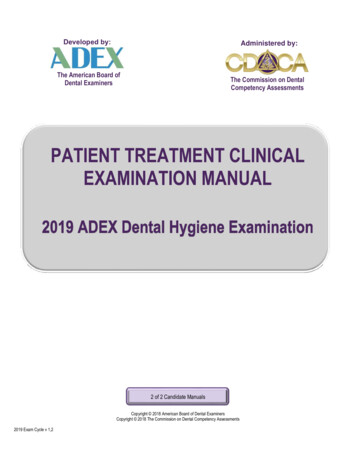
Transcription
Developed by:Administered by:The American Board ofDental ExaminersThe Commission on DentalCompetency AssessmentsPATIENT TREATMENT CLINICALEXAMINATION MANUAL2 of 2 Candidate ManualsCopyright 2018 American Board of Dental ExaminersCopyright 2018 The Commission on Dental Competency Assessments2019 Exam Cycle v 1,2
Table of ContentsExamination and Manual OverviewI. Examination Overview3A. ADEX Dental Hygiene Examination PartsB. Treatment GoalsC. Patient Treatment Clinical Examination (PTCE) Examination Schedule Guidelines1. Dates and Sites2. Time Allotment on Exam Day3. Examination Timeline4. Timely ArrivalD. Exam Day: Chairside Assistants and Interpreters1. Chairside Assistants2. InterpretersE. Candidate Professional ConductF. Infection ControlG. Scoring System OverviewH. 2019 PTCE Criteria ChartII. Patient Selection Guidelines and Online Case Entry ProcessA. Patient Selection Guidelines1. Sharing Patients2. Patient EligibilityB. Patient Medical History Requirements1. Patient Medical History Form2. Patient Medical ClearanceC. Case Selection1. What to Include in Your Case Selection2. What You CANNOT Include as Treatment Surfaces within Your Case Selection3. What is Strongly Discouraged Within Your Case Selection4. Case Selection ChecklistD. Online Case Entry ProcessIII. Instruments and RadiographsA. Instrument RequirementsB. Radiograph RequirementsIV. Exam Day AdministrationA. Candidate Preparation1. Before the Exam: Candidate Orientation2. Before the Exam: Candidate Registration SessionB. Local Anesthesia1. For Candidates Authorized to Use Injectable Local Anesthetics2. For Candidates Not Authorized to use Injectable Local Anesthetics3. Anesthesia Administration 223272727282829291
30303132323333333434353535C. Exam Flow Overview1. Set‐Up Period2. Clinic Floor Examiner (CFE) & Data Systems Manager (DSM)3. Sending Patients to the Evaluation StationD. Pre‐Treatment EvaluationE. Clinical Treatment Time1. Calculus Detection on the Three Assigned Teeth2. Calculus Removal3. Six Probing Measurements4. Tissue ManagementF. Post‐Treatment EvaluationG. Check‐Out ProceduresH. Results ReleaseIV. Examination FormsA. Forms to Complete Prior to the Examination Day1. Certification of Review of the Online Orientation2. Patient Consent, Disclosure, and Assumption of Responsibility Form3. Patient Medical History Form4. Case Selection Worksheet / Probing Measurement Findings (Front & Back)5. Online Case Selection Entry (PRINT PDF)B. Forms to Complete During the Examination1. Progress Form2. Post‐Operative Care Agreement (Complete 2 Copies of the Form)3. Check‐Out FormC. Full‐Page Form Samples1. Certification of Review of the Online Orientation2. Candidate Cubicle Card3. Patient Consent, Disclosure, and Assumption of Responsibility Form4. Dental Hygiene Flow Chart5. CFE Sign Up Sheet6. Patient Medical History Form7. Case Selection Worksheet8. Candidate Findings Worksheet (back of Case Selection Worksheet)9. Progress Form10. Post‐Operative Care Agreement11. Check‐Out FormD. Candidate PTCE 55657There are two manuals for candidates to read. This manual focuses on the PTCEportion of the ADEX Dental Hygiene Examination Series and can be brought into theclinic during the PTCE examination.2
EXAMINATION AND MANUAL OVERVIEWThe CDCA administers the ADEX clinical dental hygiene licensure examination. The ADEX dentalhygiene exam consists of a computer-based exam (CSCE OSCE) as well as a patient-basedprocedure, the Patient Treatment Clinical Examination (PTCE). All examinations are based onspecific performance criteria developed by ADEX and other content experts which will be used tomeasure the clinical competency of candidates.All candidates who take any parts of the ADEX dental hygiene examination administered by theCDCA between January 1, 2019 and December 31, 2019 are responsible for reading andunderstanding the 2019 examination manual(s) published by the CDCA, any documented changesto the 2019 manual(s), and for reviewing and understanding all other material provided by the CDCAregarding the exams administered between January 1, 2019 and December 31, 2019. Candidatesshould periodically check the CDCA website for any changes and/or updates. If any questionsarise during the registration process, candidates are responsible for communicating their questionsto the CDCA staff via email (see contact information below). Questions MUST be submitted inwriting.The CDCA has a blanket Malpractice Insurance policy that covers all dental hygiene candidatesfor all ADEX examinations. Therefore, candidates are not required to obtain additional limitedliability insurance.The CDCA reserves the right to cancel or reschedule any examination in the event of anemergency or other unforeseen circumstance that is beyond the CDCA’s control. The CDCA wouldeither refund those candidates’ application fees, reassign candidates to the next availableexamination site or reschedule the examination at the earliest possible date.Every effort has been made to ensure that this manual is accurate, comprehensive, clear, and upto-date. In the rare instances when examination related instructions need to be updated or clarifiedduring the examination year those changes will be communicated to the candidates by the CDCA.There may also be other test related material sent to candidates. These materials will be availablethrough their online candidate profiles and/or at registration on the day of the exam.Prior to taking an examination through the CDCA, each candidate must review the manualspublished by the CDCA as well as other material provided by the CDCA.Please see the Candidate Registration and CSCE OSCE Manual for step-by-step instructions onhow to register for the ADEX Dental Hygiene Examination through the CDCA, as well as guidanceregarding the CSCE OSCE registration and content. All CDCA candidate manuals can bedownloaded from the CDCA website: www.cdcaexams.org.1304 Concourse DriveSuite 100Linthicum, MD 21090www.cdcaexams.orgcontact us: https://www.cdcaexams.org/contact3
The ADEX Dental Hygiene Examination:Patient Treatment Clinical ExaminationI. EXAMINATION OVERVIEW ADEX Dental Hygiene Examination Parts Treatment Goals PTCE Examination Schedule/Timeline Guidelines Exam Day: Chairside Assistants and Interpreters Candidate Professional Conduct Infection Control Scoring System Overview (2019 ADEX PTCE Criteria)4
A. ADEX Dental Hygiene Examination PartsThe ADEX Dental Hygiene Examination is based on specific performance criteria used to measure clinicalcompetence. The ADEX Dental Hygiene Examination Committee (DHEC), which is comprised ofrepresentatives from every ADEX member district, develops and revises the PTCE. An additional committeeof content experts contributes to the ongoing development of the CSCE OSCE. These committees combinetheir members’ considerable content expertise and they also rely on practice and occupational analysissurveys, current curricula, standards of competency and the American Association of Dental Board’s (AADB)“Guidance for Clinical Licensure Examinations in Dentistry.” This ensures that the content and protocols ofthe examination are current and relevant to practice. Examination criteria, content, and evaluationmethodologies are reviewed annually.1. The Patient Treatment Clinical Examination (PTCE) evaluates candidates on their clinical andjudgment skills. Clinical skills include detection and removal of calculus, accurate periodontal pocketdepth measurements, tissue management, and final case presentation. Judgment skills includepresenting an eligible patient, diagnostic-quality radiographs that meet all examination criteria, andan acceptable case selection of teeth that meets all calculus requirements.2. The Computer Simulated Clinical Examination (CSCE OSCE) is designed to assess variouslevels of diagnosis and treatment planning knowledge, skills, and abilities. Clinically-based questionsare utilized through computer-enhanced photographs, radiographs, optical images of study andworking models, laboratory data, and other clinical digitized reproductions.NOTE: Many states require a separate jurisprudence exam. The CDCA does not administerthe jurisprudence examination for the participating boards of dentistry, except for the Stateof Florida. The respective boards of dentistry develop, administer, and score their ownjurisprudence examinations. The CDCA does not have access to, nor can it provide,jurisprudence study materials. Candidates should contact the board of dentistry in the statein which licensure is sought to arrange to take the jurisprudence examination.B. Treatment GoalsThe clinical skills procedure of the ADEX Dental Hygiene Examination evaluates a candidate’sability to: Detect calculusRemove calculus without damaging the surrounding tissueMeasure periodontal pocket depths accuratelyPresent the patient (for final evaluation) whose case selection is free of calculus,biofilm, and extrinsic stain5
C. PTCE Examination Schedule Guidelines1. Dates and SitesSpecific examination dates for a participating dental hygiene program can be found on the CDCAwebsite. Dates are determined through collaboration between the Program Director or other officialrepresentative of the dental hygiene program and the CDCA. Please refer to the Registration andCSCE OSCE Manual for the CDCA’s specific policies and administrative guidelines.In the event there are extenuating circumstances such as weather, acts of God, or other unforeseencircumstances which may impact or alter the schedule and administration of the examination(s), theCDCA will make every attempt to contact candidates with updated information.2. Time Allotment on Exam Day:4 HOURS 15 MINUTES TOTALPatient Treatment time: 2 hours Pre-treatment evaluation takes approximately 30-35 minutes Note: The CDCA is not responsible for the malfunction of the facility’s or the candidate’sequipment and may or may not allot additional time due to the malfunction of any equipment.Equipment maintenance personnel are onsite during each examination to ensure theequipment and the water are in working order. At the site, should an equipment malfunctionoccur prior to or during the examination, the candidate must immediately notify the CFE orDSM so the appropriate personnel may be contacted.3. Examination Timelines (AM Session and PM Session):AM SESSION6:45am –7:15am7:15am –7:45am7:45am9:30am10:00am*12:00pmCandidate registration sessionCandidate set-up period in clinic(CFEs will be available to checkmedical histories and radiographs)EXAM START: patients who arechecked in can be sent to theEvaluation StationTo maximize full 2-hrs of treatmenttime, patient must be signed in forpre-treatment evaluationDeadline for sign-in to theEvaluation StationEXAM ENDS: all patients must be inthe Evaluation Station for posttreatment evaluationPM SESSION11:45am –12:15pm12:15pm –12:45pm12:45pm2:30pm3:00pm*5:00pmCandidate registration sessionCandidate set-up period in clinic(CFEs will be available to checkmedical histories and radiographs)EXAM START: patients who arechecked in can be sent to theEvaluation StationTo maximize full 2-hrs of treatmenttime, patient must be signed in forpre-treatment evaluationDeadline for sign-in to theEvaluation StationEXAM ENDS: all patients must be inthe Evaluation Station for posttreatment evaluation*Any candidate who has been delayed will be allowed to take the exam as long as 90 minutesof patient treatment time are available. This means that the patient must be signed in for pretreatment evaluation no later than 10:00am or 3:00pm in order to receive a start time of10:30am or 3:30pm, thus allowing 90 minutes for patient treatment. No candidate may beginthe exam if they have not signed their patient in by the 10:00am or 3:00pm deadline.6
4. Timely ArrivalCandidates are responsible for determining their travel and time schedules to ensure they can meet allof the CDCA’s time requirements. All candidates are expected to arrive at the examination site at theirdesignated time, which will be communicated to them via their online candidate profiles (under the“Apply” tab of the candidate profile). Failure to follow this guideline may result in not being permitted tostart the examination.Candidates will be informed in their online candidate profiles as to the date and session on which theyare assigned to challenge the PTCE. Examination schedules are not finalized until after theexamination application deadline. Candidates should note the specific timelines for their assignedsession, and the examination must be completed within the allotted time.D. Exam Day: Chairside Assistants and Interpreters1. Chairside assistants are NOT permitted for the PTCE2. Candidates may utilize the services of an interpreter when their patient does not speak Englishor for a patient whose hearing impairment cannot be corrected (this is particularly important whenthe patient has a history of medical problems or is on medications).However, an interpreter may NOT be: Younger than eighteen (18) years old A faculty member A licensed or unlicensed dentist or dental hygienist A fourth year (or final year) dental or final year dental hygiene studentCandidates who requires an Interpreter Disclosure Statement and Interpreter ID Form shouldrequest one from the Chief during the Candidate Registration Session that takes place prior tothe exam. Candidates will complete the form entirely once they arrive to their cubicle in the clinic,and two (2) passport-size photographs (2x2 photos) of the interpreter must be affixed in theappropriate places on the form. The candidate and the interpreter should then request the Chiefto approve the interpreter. The interpreter must present two forms of ID, one with a photo, andboth with a signature, in order to be approved. Once the interpreter is approved and registered,he/she will be given an ID badge, which must be worn at all times while in the examination area,and the badge must be turned in by the candidate at the conclusion of the examination along withall other required forms and materials.Candidates are responsible for the conduct of their interpreter during the examination. While thereis no strict dress code for interpreters, candidates must be mindful of the fact that the examinationsite is a professional setting and all personnel should be appropriately dressed.Interpreters are required to wear their ID badge at all times, on their outer-most clothing,while in the examination area.7
E. Candidate Professional ConductIntegrity of the examination process depends on fairness, accuracy and consistency. Standards arerequired to ensure that these principles are adhered to by examiners and candidates. Penalties areimposed for violations of such examination guidelines and the penalties are proportional to theseriousness of the violation. Minor violations may result in a warning or reminder. Serious violationsmay result in a failure of the examination. Candidates are required to adhere to these standards ofconduct while participating in the ADEX Dental Hygiene Examination.1. Submission of examination records: All required examination records must be turned in tothe CFE in the white candidate envelope before the examination is considered complete.2. Registered/assigned procedures: Only the treatment and/or procedures for which acandidate has registered, paid for, and been assigned to on the specified examinationdate may be performed. Performing other treatment and/or procedures may result intermination of the examination.3. Professional Misconduct: Professional misconduct is a most serious violation ofexamination guidelines. Substantiated evidence of professional misconduct (see examplesbelow) during the course of the examination will result in automatic failure of the entireexamination series. In addition, there will be no refund of examination fees and thecandidate will not be allowed to reapply for re-examination for one year from the time of theinfraction.Professional misconduct includes, but is not limited to: Falsification or intentional misrepresentation of registration requirementsCheating of any kindDemonstrating complete disregard for the oral structures or welfare of the patientMisappropriation of equipment (theft)Receiving unauthorized assistanceAlteration of examination records and/or radiographsFailure to follow instructions from examinersRude, abusive, uncooperative or disruptive behavior toward patients, examiners, orother candidates Use of electronic equipment, to include recording devices, phones, and/or cameras(*candidates, patients, and interpreters are prohibited from the use of any electronicdevices during the course of the examination)F.Infection ControlThe current recommended infection control procedures as published by the Centers for DiseaseControl and Prevention must be followed for the PTCE. These procedures must begin with theinitial setting up of the unit, continue throughout the course of the examination and include thefinal cleanup of the operatory. Failure to comply will result in the loss of points and any violationthat could lead to direct patient harm will result in termination of the examination and loss of allpoints.8
To the extent possible, dental professionals must prevent the spread of infectious diseases.Because many infectious patients are asymptomatic, all patients shall be treated as if they are,in fact infectious. Use of universal precautions including barriers, disposables wheneverpossible, and proper disinfection and sterilization is required. The following infection controlprocedures shall be strictly adhered to.Automatic External Defibrillator (AED) equipment, pocket masks, resuscitation bags, orother ventilation devices will likely be provided by the school in strategic locations.Candidates should be familiar with their location and use.Personal Protective Equipment/Barriers Gloves, masks and eye protection must be worn when setting up or performing any intraoral procedures and when cleaning up after any treatment. If rips or tears occur, newgloves must be donned. Gloves are not to be worn outside the operatory. Patients withknown allergies to latex will NOT be allowed to participate for the examination, unlessthe clinic is certified as latex-free. Hand washing must occur prior to patient treatment,during patient treatment if glove(s) are compromised and when gloves are removed.Alcohol hand sanitizer (60% alcohol or greater) is permitted in place of hand washingonly if hands are not visibly soiled. No rings that can tear gloves or wrist jewelry, excepta watch, is permitted. Clean long-sleeved uniforms, gowns, or laboratory coats are to be worn and must bechanged if they become visibly soiled. Gowns must be closed at the neck. Gowns orlaboratory coats are to be removed before leaving the clinic area. Face masks and protective eyewear with side shields must be worn during all proceduresin which splashing of any body fluids is likely to occur. Masks are to be discarded aftereach patient or sooner if the masks become damp or soiled. Footwear may not include sandals, perforated clogs or open-toed shoes (a safety issuerather than strictly infection control). Impervious-backed paper, aluminum foil, or plastic wrap may be used to cover surfacesin the operatory that may become contaminated. The coverings must be removed (whilegloved), discarded, and replaced (after removing gloves) between patients. A clean patient napkin must be worn by the patient each time he/she goes to theEvaluation Station. Patients must wear protective eyewear during all clinical procedures and are required tobring protective eyewear with them to the Evaluation Station for use during the evaluationof clinical procedures.Sterilization and Disinfection Instruments, gloves, and other materials that become contaminated must be placed inappropriate receptacles.
portion of the ADEX Dental Hygiene Examination Series and can be brought into the clinic during the PTCE examination. C. Exam Flow Overview 30 1. Set‐Up Period 30 2. Clinic Floor Examiner (CFE) &am

